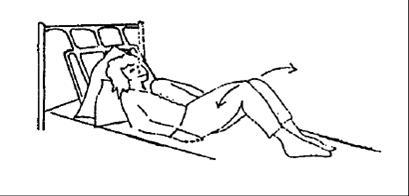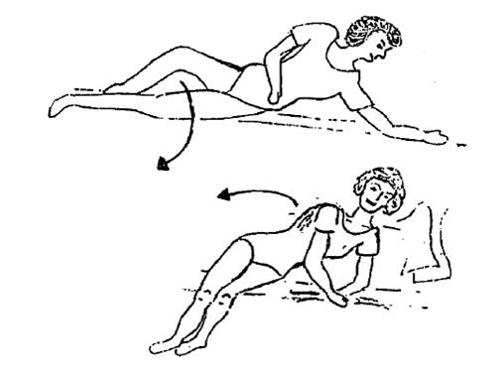Day 1
Knee rolling
This exercise can help relieve wind and can help reduce any stiffness in your back.
Lying in bed with your head on a pillow and your knees bent up, feet flat. Gently let both knees roll to one
side, return to the middle then repeat to the other side. Remember to breathe. Do this a few times to each side.

Day 2:
You should continue your day 1 exercises and add in the following ones.
Abdominal hollowing
Lie in bed with your knees bent up and your feet flat on the bed. Gently breathe in, and as you breathe out gently draw your lower tummy muscles in towards your spine. Keep these muscles drawn in as you breathe normally and then release. Repeat x5. As you feel more confident with this exercise you can practise it in sitting and standing.
Pelvic tilts
Lie in bed with your head on a pillow and your knees bent, feet flat. Pull in your tummy muscles and press the small of your back into the bed. Hold for up to five seconds and then slowly relax. Repeat this 5-10 times, three times a day. This can also help reduce trapped wind and help reduce any stiffness in your back.
Pelvic floor exercises
The pelvic floor muscles act as a sling and form the floor of the pelvis. They hold up and help to control the bladder, womb and the back passage. If they are weakened you may experience urinary leakage with coughing, sneezing or moving quickly (known as stress urinary incontinence). You may also be at risk of developing a prolapse.

Pelvic floor exercises are essential in keeping these muscles strong and therefore reduce the risk of stress
incontinence or prolapse. You may have already started these prior to surgery under the guidance of a
physiotherapist in the Bladder, Bowel and Pelvic Floor Service. Do continue these after your surgery once your catheter is removed and you’re passing urine normally.
Do not do these exercises if you have a catheter or if you are struggling to pass urine.
IF YOU HAVE HAD A TVTO OPERATION FOR STRESS INCONTINENCE DO NOT DO THESE EXERCISES FOR 6 WEEKS.
How to exercise your pelvic floor muscles
- Imagine that you are trying to stop yourself from passing wind at the same time as trying stop passing urine. You will feel both your front and back passage closing. This is normal. Hold for up to 5 seconds, continuing to breathe normally, and then slowly relax for 4 seconds. Repeat this exercise 5 times.
- Now try up to 10 fast squeezes, tightening the muscles quickly and then immediately relaxing them.
- You can exercise these muscles in lying, sitting or standing.
- Always allow the muscles to fully relax after each squeeze.
- Advice when practising pelvic floor exercises
- Try to repeat both exercises 3 times a day.
- Don’t hold your breath when exercising.
- Try to relax your tummy and leg/buttock muscles.
- Before you cough, sneeze or lift anything, gently tighten your pelvic floor muscles and relax when you are finished. This is known as the KNACK.
- Try to avoid constipation, where possible, and do not strain to move your bowel.
- Build up your exercises gradually. If the muscles are initially weak it can take 3-5 months to improve the strength. Regular, consistent exercise is key to success. Pelvic floor exercises are for life.
- DO NOT DO A MIDSTREAM STOP AS THIS MAY LEAD TO PROBLEMS PASSING URINE.
Getting back to normal after you get home
In the early days - try to avoid standing still for long periods (30 mins or more). It is important to avoid heavy lifting eg the hoover, a full kettle, a bag of shopping. As you recover gradually build up your walking and general activity but listen to your body. If something feels uncomfortable, stop, and revisit it a few days later.
Driving
Depending on your rate of recovery you should not drive before 2-4 weeks after your operation. Some people may take up to 6 weeks.
You must consider:
- Can you concentrate? Are you taking medication that may impair this?
- Can you do an emergency stop?
- Do you feel comfortable turning your body to perform manoevres eg looking over your shoulder to reverse?
- Once you are ready start by driving short distances. It is recommended you check your car insurance policy prior to returning to driving.
Sport and activity
You will be tired after your operation as your body uses energy to heal and recover.
Walking – start gradually and slowly increase pace until you can walk at your normal speed without tiring. Start on flat ground if possible and slowly increase the distance that you are walking.
You may feel ready to start light general exercise 3-6 weeks after your operation. Swimming can be started approx 6 weeks after your surgery providing your wound is fully healed and any discharge or bleeding has stopped.
You should usually allow 4-6 weeks before resuming sex as long as you feel comfortable.
References:
- Royal College of Obstetricians and Gynaecologists. Patient Information Leaflet; pelvic floor repair operation - recovering well. (Oct 2023)
- Good Practice Statement from the POGP (Pelvic Obstetric and Gynaecological Physiotherapy): Driving after gynaecological surgery and Caesarean section after delivery. June 2017.
- Fit following surgery: advice and exercise following major gynaecological surgery. Published by POGP. Feb 2022.




